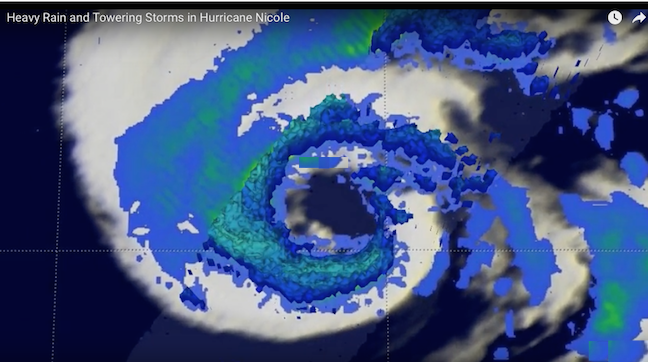
Just as Matthew's devastation is still fresh in everyone's mind, along comes the destructive lass, Hurricane Nicole, a wet and wild storm.
The Global Precipitation Measurement mission or core GPM satellite passed over Nicole in the North Atlantic Ocean on October 17 at 12:36 a.m. EDT (0436 UTC). The GPM satellite analyzed the rainfall in Nicole's large ragged eye. GPM's Dual-Frequency Precipitation Radar (DPR) swath sliced through the center of Nicole's eye and found some very heavy rainfall. A few strong storms in the southern side of the eye were dropping rain at a rate of over 113 mm (4.4 inches) per hour.
GPM's radar (DPR KU band) data collected with this pass were used in a 3-D examination of storm top heights. GPM found that the most powerful storms in Nicole's eye were reaching heights of only about 12 km (7.4 miles). GPM is a joint mission between NASA and the Japanese space agency JAXA.
At 11 a.m. EDT (1500 UTC) on October 17 the center of Hurricane Nicole was located near 41.4 degrees north latitude and 44.6 degrees west longitude. That's about 560 miles (900 km) southeast of Cape Race, Newfoundland, Canada.
The National Hurricane Center (NHC) said Nicole was moving toward the north-northeast near 9 mph (15 kph), and this general heading with a significant increase in forward speed is expected during the next couple of days. Maximum sustained winds are near 75 mph (120 kph) with higher gusts. Little change in strength is forecast during the next 48 hours. However, Nicole should lose its tropical characteristics by early Tuesday, October 18.
Nicole is a large hurricane. NHC estimated hurricane-force winds extend outward up to 90 miles (150 km) from the center and tropical-storm-force winds extend outward up to 415 miles (665 km). The estimated minimum central pressure is 962 millibars.
Nicole is expected to continue producing hurricane force winds while moving northward over the cooler waters of the North Atlantic Ocean. NHC predicts that Nicole's center will cool and transition to a strong extra-tropical cyclone on October 18 as it heads toward Iceland.
Nicole has left a lasting impression on the ocean as swells from the storm are expected to affect a great deal of coastlines. The National Hurricane Center noted that "large swells associated with Nicole will affect the United States east coast, the coast of Atlantic Canada, Bermuda, the Bahamas, the Greater Antilles, the Leeward Islands, and the Azores islands for the next several days, creating dangerous surf conditions and rip currents. These swells are also likely to reach Europe and the northwest coast of Africa in a day or two."
https://www.nasa.gov/feature/goddard/2016/nicole-atlantic-ocean

